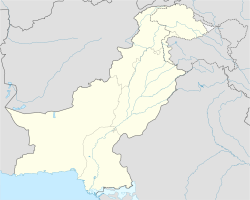Top Qs
Timeline
Chat
Perspective
Uthal Tehsil
Pakistani administrative area From Wikipedia, the free encyclopedia
Remove ads
Uthal (Balochi: اوتھل, Urdu pronunciation: [ˈʊt̪ʰəl]) is an administrative subdivision (tehsil) in Lasbela District, located in the southeastern part of Balochistan, Pakistan. According to the 2023 national census, the tehsil has a population of 88,933, dispersed across 159 settlements.[5] It comprises two Union Council, with the town of Uthal, a designated municipal council, serving as the administrative centre for both the tehsil and the district.
Remove ads
Geography
Uthal covers approximately 1,756 square kilometres.[2] It shares borders with Bela and Kanraj tehsils to the north and east, Dureji and Sonmiani tehsils, now part of Hub District, to the east and south, while Liari and Lakhra lie to its west. The landscape is largely arid and rugged, characterised by hilly terrain, dry riverbeds, and seasonal watercourses. Among its key natural features is the Kharari River, which plays a vital role in supporting agriculture and maintaining local biodiversity.
Remove ads
Climate
The tehsil experiences an arid climate (Köppen classification: BWh).[1] Winters are short and mild, with average daytime temperatures around 16 °C (61 °F), and nighttime lows occasionally dropping to 0 °C (32 °F). Vegetation is xerophytic, consisting of drought-resistant shrubs, scattered trees, and seasonal ground cover adapted to arid conditions.
Population
According to 2023 census, Tehsil had 88,933 population living in 14,278 households, 8,456 in rural areas containing 51,862 people and 5,822 in urban areas containing 37,071 people.[7]
Languages
In Uthal Tehsil, Balochi is the predominant language, spoken by approximately 65,052 individuals (~73.2%) of the population. Other languages include Sindhi (13,614 speakers, ~15.3%), and Brahui (2,377 speakers, ~2.7%) with the remaining population speaking various other languages.[4] It is important to note that the Sindhi reported in this context largely refers to Lasi, a distinct local dialect of Sindhi also spoken in the costal districts of Balochistan.[8]
Remove ads
Education
Access to education and learning outcomes have traditionally been low.[9] The overall literacy rate stands at 33.95%, with a significant gender gap: 42.72% for males and only 23.99% for females.[3] These figures reflect ongoing challenges in education access, particularly for women and girls.
Efforts to improve primary education include an academic supervision and mentoring programme supported by the Government of Balochistan, UNICEF, and the Global Partnership for Education. By introducing activity-based learning and regular teacher mentoring in local schools, the initiative aims to strengthen teaching quality and student engagement. It has been especially impactful for girls.[9]
For higher education, Uthal hosts the Lasbela University of Agriculture, Water and Marine Science and the Khuzdar Engineering University has a campus in Uthal.
Remove ads
Economy
According to recent data, 78.5% of households in Uthal Tehsil are classified as poor, with 22.6% falling into the category of very poor.[10] The local economy includes small-scale livestock markets, and the Government of Balochistan has established the Uthal Industrial Trading Estate through the Lasbela Industrial Estates Development Authority to promote industrial activity and support economic development in the area.[11]
Remove ads
Floods
The 2022 floods in Balochistan had a particularly severe impact on impact on Uthal Tehsil, resulting in significant human losses, widespread destruction of civic infrastructure, and the devastation of entire harvests.[12] Recovery efforts have been slow, highlighting the region's vulnerability to climate-related disasters.[13]
See also
References
Wikiwand - on
Seamless Wikipedia browsing. On steroids.
Remove ads



